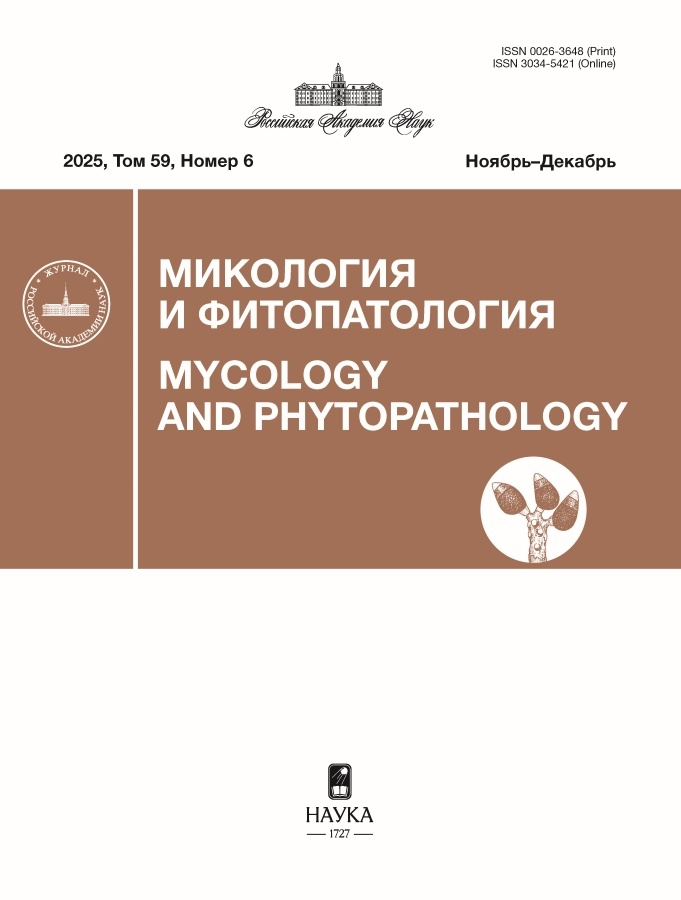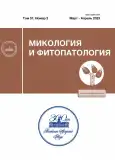Эффективность использования энтомопатогенного гриба Metarhizium robertsii против ризоктониоза картофеля
- Авторы: Шалдяева Е.М.1,2, Пилипова Ю.В.2, Томилова О.Г.1,3, Глупов В.В.1
-
Учреждения:
- Институт систематики и экологии животных СО РАН
- Новосибирский государственный аграрный университет
- Всероссийский научно-исследовательский институт защиты растений
- Выпуск: Том 57, № 2 (2023)
- Страницы: 134-140
- Раздел: ГРИБЫ – ВОЗБУДИТЕЛИ БОЛЕЗНЕЙ РАСТЕНИЙ
- URL: https://journals.rcsi.science/0026-3648/article/view/138058
- DOI: https://doi.org/10.31857/S0026364823020095
- EDN: https://elibrary.ru/NJCLEU
- ID: 138058
Цитировать
Полный текст
Аннотация
Впервые в Западной Сибири проведены производственные испытания экспериментального прототипа препарата на основе энтомопатогенного гриба Metarhizium robertsii. Показана его способность существенно сдерживать развитие ризоктониоза картофеля на протяжении всего периода вегетации. Установлено достоверное снижение гибели ростков и развития ризоктониоза на стеблях в сравнении с контролем и химическим протравителем. На участке с применением M. robertsii отмечено существенное увеличение количества здоровых клубней (в 2.5 раза), количество клубней со склероциями уменьшилось в 2.8 раза по сравнению с контролем. Эффективность применения M. robertsii в подавлении ризоктониоза была высокой на всех этапах онтогенеза картофеля и составляла 52–84%. В лабораторных экспериментах в присутствии М. robertsii установлено достоверное ингибирование формирования склероциев Rhizoctonia solani на клубнях, снижение их жизнеспособности и размера.
Ключевые слова
Об авторах
Е. М. Шалдяева
Институт систематики и экологии животных СО РАН; Новосибирский государственный аграрный университет
Автор, ответственный за переписку.
Email: elenashaldyaeva@mail.ru
Россия, 630091, Новосибирск; Россия, 630039, Новосибирск
Ю. В. Пилипова
Новосибирский государственный аграрный университет
Автор, ответственный за переписку.
Email: pyuv260565@mail.ru
Россия, 630039, Новосибирск
О. Г. Томилова
Институт систематики и экологии животных СО РАН; Всероссийский научно-исследовательский институт защиты растений
Автор, ответственный за переписку.
Email: toksina@mail.ru
Россия, 630091, Новосибирск; Россия, 196608, Санкт-Петербург
В. В. Глупов
Институт систематики и экологии животных СО РАН
Автор, ответственный за переписку.
Email: skif61@list.ru
Россия, 630091, Новосибирск
Список литературы
- Abramoff M.D., Magelhaes P.J., Ram S.J. Image processing with Image. J. Biophotonics Int. 2004. V. 11 (7). P. 36–42.
- Baker K.F. Types of Rhizoctonia diseases and their occurrence. In: J. R. Parmeter (ed.). Rhizoctonia solani: Bio-logy and pathology. San-Francisco, 1970. P. 125–148.
- Bark Y.G., Lee D.G., Kim Y.H. et al. Antibiotic properties of an entomopathogenic fungus, Beauveria bassiana, on Fusarium oxysporum and Botrytis cinerea. Korean J. Plant Pathology. 1996. V. 12. P. 245–250.
- Bruck D.J. Fungal entomopathogens in the rhizosphere. Biocontrol. 2010. V. 55. P. 103–112. https://doi.org/10.1007/s10526-009-9236-7
- Carling D.E., Leiner R.H., Westphale P.C. Symptoms, sings and yield reduction associated with Rhizoctonia disease on potato induced by tuberborne inoculum of Rhizoctonia solani Ag-3. American Potato J. 1989. V. 66. P. 693–701.
- Collemare J., Griffiths S., Yuichiro L. et al. Secondary metabolism and biotrophic lifestyle in the tomato pathogen Cladosporium fulvum. PLOS One, 2014. V. 9. e85877. https://doi.org/10.1371/journal.pone.0085877
- Flori P., Roberti R. La concia dei bulbi di cipolla con antagonisti fungini per il contenimento di Fusarium oxysporum f. sp. cepae. La difesa delle piante. 1993. V. 16. P. 5–12.
- Frank J.A., Leach S.S., Webb R.A. Evaluation of potato clone reaction to Rhizoctonia solani. Plant Dis. Rep. 1976. V. 60 (11). P. 910–912.
- Garrido-Jurado I., Resquín-Romero G., Amarilla S.P. et al. Transient endophytic colonization of melon plants by entomopathogenic fungi foliar applications for the control of Bemisia tabaci Gennadius (Hemiptera: Aleyrodidae). J. Pest. Sci. 2017. V. 90 (1). P. 319–330. https://doi.org/10.1007/s10340.016.0767-2
- Hammer Ø., Harper D.A.T., Ryan P.D. PAST: Paleontological statistics software package for education and data analysis. Palaeontologia Electronica. 2001. V. 4 (1). P. 1–9.
- Henis Y., Ghaffar A.R., Baker R. A new pellet soil-sample and its use for the study of population dynamics of Rhizoctonia solani. Phytopathology. 1978. V. 19. P. 1269–1273.
- Hirano E., Koike M., Aiuchi D. et al. Pre-inoculation of cucumber roots with Verticillium lecanii (Lecanicillium muscarium) induces resistance to powdery mildew. Res. Bull. Obihiro Univ. 2008. V. 29. P. 82.
- Hu G., St Leger R.J. Field studies using a recombinant mycoinsecticide (Metarhizium anisopliae) reveal that it is rhizosphere competent. Appl. Envir. Microbiol. 2002. V. 68 (12). P. 6383–6387 https://doi.org/10.1128/AEM.68.12.6383-6387.2002
- Jaber L.R., Salem N.M. Endophytic colonisation of squash by the fungal entomopathogen Beauveria bassiana (Ascomycota: Hypocreales) for managing Zucchini yellow mosaic virus in cucurbits. Biocontrol Sci. Technol. 2014. V. 24(10). https://doi.org/10.1080/09583157.2014.923379
- Kim J.J., Goettel M.S., Gillespie D.R. Evaluation of Lecanicillium longisporum, Vertalec® against the cotton aphid, Aphis gossypii, and cucumber powdery mildew, Sphaerotheca fuliginea in a greenhouse environment. Crop Protection. 2010. V. 29 (6). P. 540–544.
- Ko W., Hora F.K. A selective medium for the quantitative determination of the Rhizoctonia solani in soil. Phytopathology. 1971. V. 61. P. 707–710.
- Kryukov V.Y., Yaroslavtseva O.N., Tyurin M.V. et al. Ecological preferences of Metarhizium spp. from Russia and neighboring territories and their activity against Colorado potato beetle larvae. J. Invertebr. Pathol. 2017. V. 149. P. 1–7.
- Lednev G.R., Levchenko M.V., Pavlyushin V.A. Modern approaches to the development and use of mycoinsecticides to reduce the number of harmful arthropods. In: Abstracts of IV All-Russian Congress on Plant Protection with international participation “Phytosanitary technologies in ensuring the independence and competitiveness of the agro-industrial complex of Russia”. St. Petersburg, 2019 (in Russ.).
- Lozano-Tovar M.D., Garrido-Jurado I., Quesada-Moraga E. et al. Metarhizium brunneum and Beauveria bassiana release secondary metabolites with antagonistic activity against Verticillium dahliae and Phytophthora megasperma olive pathogens. Crop Protection. 2017. V. 100. P. 186–195.
- Maksimov I.V., Sorokan A.V., Nafikova A.R. et al. On principal ability and action mechanisms of joint use of Bacillus subtilis 26D and Beauveria bassiana Ufa-2 preparation for potato protection against Phytophthora infestans and Leptinotarsa decemlineata. Mikologiya i fitopatologiya 2015. V. 49 (5). P. 317–324.
- Ownley B.H., Pereira R.M., Klingeman W.E. et al. Beauveria bassiana, a dual purpose biological control with activity against insect pests and plant pathogens. In: R.T. Lartey and A.J. Caesar (eds). Emerging Concepts in Plant Health Management. Research Signpost, Dehli, 2004, pp. 255–269.
- Ownley B.H., Dee M.M., Gwinn K. Effect of conidial seed treatment rate of entomopathogenic Beauveria bassiana 11-98 on endophytic colonization of tomato seedlings and control of Rhizoctonia disease. Phytopathology. 2008. V. 98. P. 118.
- Ownley B.H., Gwinn K.D., Vega F.E. Endophytic fungal entomopathogens with activity against plant pathogens: ecology and evolution. BioControl. 2010. V. 55. P. 113–128. https://doi.org/10.1007/s10526-009-9241-x
- Renwick A., Campbell R., Coe S. Assessment of in vivo screening systems for potential biocontrol agents of Gaeumannomyces graminis. Plant Pathol. 1991. V. 40. P. 524–532.
- Ríos-Moreno A., Garrido-Jurado I. Resquín-Romero G. et al. Destruxin A production by Metarhizium brunneum strains during transient endophytic colonisation of Solanum tuberosum. Biocontrol Sci. Technol. 2016. V. 26 (11). P. 1574–1585.
- Sasan R.K., Bidochka M.J. Antagonism of the endophytic insect pathogenic fungus Metarhizium robertsii against the bean plant pathogen Fusarium solani f. sp. phaseoli. Can. J. Plant Pathol. 2013. V. 35 (3). P. 288–293. https://doi.org/10.1080/07060661.2013.823114
- Serebrov V., Maljarchuk A., Shrernshis M., Spontaneous variability of Metarhizium anisopliae (Metsch.) sor. strains as an approach for enhancement of insecticidal activity. Plant Sci. (Sofia) 2007. V. 44. 236e239.
- Shaldyaeva E.M., Pilipova Yu.V. Potato rhizoctoniosis: sclerocial index. Zashchita i karantin rasteniy. 1999. V. 5. P. 16–17 (in Russ.).
- Shaldyaeva E.M., Pilipova Yu.V., Konyaeva N.M. Monitoring of rhizoctoniosis in agroecosystems of potatoes in Western Siberia. Novosibirsk, 2006 (in Russ.).
- Shaldyaeva E.M., Pilipova Yu.V. Harmful organisms of potato agroecosystems in the forest-steppe of Western Siberia and their evolutionary and ecological adaptations. Sibirskiy vestnik selskokhozyaystvennoy nauki. 2017. V. 41 (1). P. 65–73 (in Russ.).
- Tomilova O.G., Shaldyaeva E.M., Kryukova N.A. et al. Entomopathogenic fungi decrease Rhizoctonia disease in potato in field conditions. St. Petersburg, 2020.
- Tsror L. Biology, ecology and management of Rhizoctonia solani on potato. J. Phytopathol. 2010. V. 158. P. 649–658.
- Vega F.E. The use of fungal entomopathogens as endophytes in biological control: a review. Mycologia. 2018. V. 110 (1). P. 4–30. https://doi.org/10.1080/00275514.2017.1418578
- Wilson P.S., Ahvenniemi P.M., Lehtonen M.J. et al. Biological and chemical control and their combined use to control different stages of the Rhizoctonia disease complex on potato through the growing season. Annls Appl. Biol. 2008. V. 153. P. 307–320.
- Леднев Г.Р., Левченко М.В., Павлюшин В.А. (Lednev et al.) Современные подходы к разработке и применению микоинсектицидов для снижения численности вредных членистоногих // Сборник тезисов докладов IV Всероссийского съезда по защите растений с международным участием “Фитосанитарные технологии в обеспечении независимости и конкурентоспособности АПК России”. СПб., 2019.
- Шалдяева Е.М., Пилипова Ю.В. (Shaldyaeva, Pilipova) Ризоктониоз картофеля: склероциальный индекс // Защита и карантин растений. 1999. № 5. С. 16–17.
- Шалдяева Е.М., Пилипова Ю.В., Коняева Н.М. (Shaldya-eva et al.) Мониторинг ризоктониоза в агроэкосис-темах картофеля Западной Сибири. Новосибирск, 2006. 200 с.
- Шалдяева Е.М., Пилипова Ю.В. (Shaldyaeva, Pilipova) Вредные организмы агроэкосистем картофеля лесостепи Западной Сибири и их эволюционно-экологические адаптации // Сибирский вестник сельскохозяйственной науки. 2017. Т. 41. № 1. С. 65–73.
Дополнительные файлы












